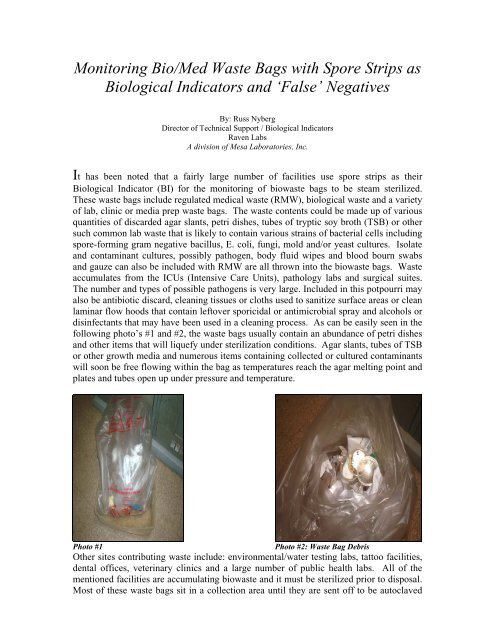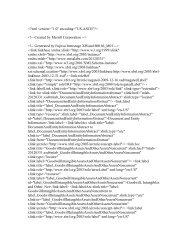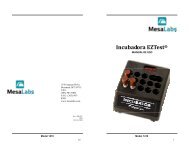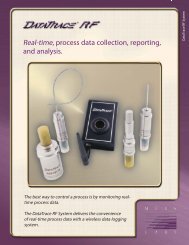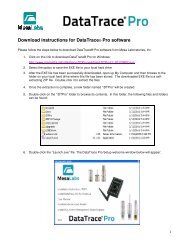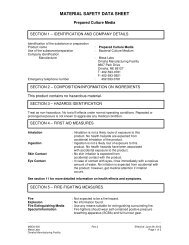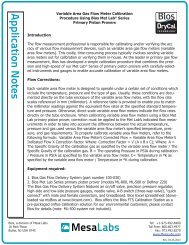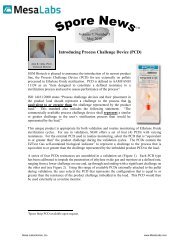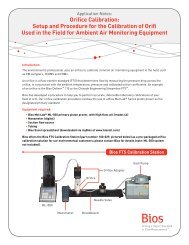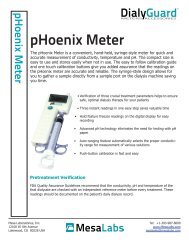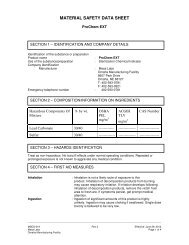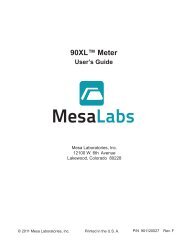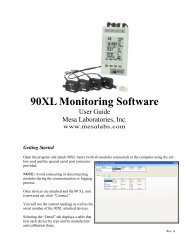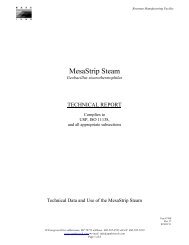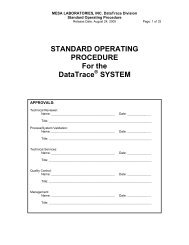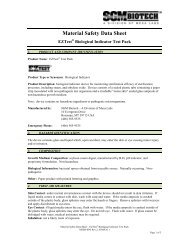Monitoring Bio/Med Waste Bags with Spore Strips as ... - Mesa Labs
Monitoring Bio/Med Waste Bags with Spore Strips as ... - Mesa Labs
Monitoring Bio/Med Waste Bags with Spore Strips as ... - Mesa Labs
Create successful ePaper yourself
Turn your PDF publications into a flip-book with our unique Google optimized e-Paper software.
<strong>Monitoring</strong> <strong>Bio</strong>/<strong>Med</strong> <strong>W<strong>as</strong>te</strong> <strong>Bags</strong> <strong>with</strong> <strong>Spore</strong> <strong>Strips</strong> <strong>as</strong><br />
<strong>Bio</strong>logical Indicators and ‘False’ Negatives<br />
By: Russ Nyberg<br />
Director of Technical Support / <strong>Bio</strong>logical Indicators<br />
Raven <strong>Labs</strong><br />
A division of <strong>Mesa</strong> Laboratories, Inc.<br />
It h<strong>as</strong> been noted that a fairly large number of facilities use spore strips <strong>as</strong> their<br />
<strong>Bio</strong>logical Indicator (BI) for the monitoring of biow<strong>as</strong>te bags to be steam sterilized.<br />
These w<strong>as</strong>te bags include regulated medical w<strong>as</strong>te (RMW), biological w<strong>as</strong>te and a variety<br />
of lab, clinic or media prep w<strong>as</strong>te bags. The w<strong>as</strong>te contents could be made up of various<br />
quantities of discarded agar slants, petri dishes, tubes of tryptic soy broth (TSB) or other<br />
such common lab w<strong>as</strong>te that is likely to contain various strains of bacterial cells including<br />
spore-forming gram negative bacillus, E. coli, fungi, mold and/or ye<strong>as</strong>t cultures. Isolate<br />
and contaminant cultures, possibly pathogen, body fluid wipes and blood bourn swabs<br />
and gauze can also be included <strong>with</strong> RMW are all thrown into the biow<strong>as</strong>te bags. <strong>W<strong>as</strong>te</strong><br />
accumulates from the ICUs (Intensive Care Units), pathology labs and surgical suites.<br />
The number and types of possible pathogens is very large. Included in this potpourri may<br />
also be antibiotic discard, cleaning tissues or cloths used to sanitize surface are<strong>as</strong> or clean<br />
laminar flow hoods that contain leftover sporicidal or antimicrobial spray and alcohols or<br />
disinfectants that may have been used in a cleaning process. As can be e<strong>as</strong>ily seen in the<br />
following photo’s #1 and #2, the w<strong>as</strong>te bags usually contain an abundance of petri dishes<br />
and other items that will liquefy under sterilization conditions. Agar slants, tubes of TSB<br />
or other growth media and numerous items containing collected or cultured contaminants<br />
will soon be free flowing <strong>with</strong>in the bag <strong>as</strong> temperatures reach the agar melting point and<br />
plates and tubes open up under pressure and temperature.<br />
Photo #1<br />
Photo #2: <strong>W<strong>as</strong>te</strong> Bag Debris<br />
Other sites contributing w<strong>as</strong>te include: environmental/water testing labs, tattoo facilities,<br />
dental offices, veterinary clinics and a large number of public health labs. All of the<br />
mentioned facilities are accumulating biow<strong>as</strong>te and it must be sterilized prior to disposal.<br />
Most of these w<strong>as</strong>te bags sit in a collection area until they are sent off to be autoclaved
either on-site or off-site. Many sites use BIs in the form of spore strips to me<strong>as</strong>ure the<br />
cycle’s effectiveness. Could just the presence of this hodgepodge of w<strong>as</strong>te items<br />
discarded into the bags have a localized effect upon the spore strips being used to monitor<br />
a sterilization cycle Prior to providing information pertaining to the above question, let’s<br />
look at why spore strips are even being used <strong>as</strong> BIs for biow<strong>as</strong>te cycles.<br />
The most common form of BI used <strong>as</strong> an indicator for monitoring sterilization cycles<br />
involving steam is the spore strip. <strong>Spore</strong> strips are fairly e<strong>as</strong>y to use, they are the le<strong>as</strong>t<br />
expensive of BIs to purch<strong>as</strong>e and most individuals using BIs are familiar <strong>with</strong> the use of<br />
spore strips. Of the regulatory standards that require the use of BIs for monitoring<br />
medical or biological w<strong>as</strong>te, they specifically mention and allow for the use of spore<br />
strips in autoclaves. When one is preparing for environmental laboratory accreditation or<br />
certification, autoclaves must be monitored <strong>with</strong> spore strips or suspensions. 1<br />
The broad category of ‘autoclave loads’ would also encomp<strong>as</strong>s biow<strong>as</strong>te loads.<br />
Numerous agencies, including many State Department of Health agencies follow the four<br />
proposed sterility <strong>as</strong>surance levels for microbial inactivation set by the US State and<br />
Territorial Association on Alternative Treatment Technologies (STAATT) for the<br />
treatment of medical/clinical w<strong>as</strong>te. RMW/biow<strong>as</strong>te requires a Level 3 minimum for<br />
treatment. With Level 3, the use of a minimum challenge of Log 4 population is used.<br />
As an example of citing spore strip use, the recently approved Code of M<strong>as</strong>sachusetts<br />
Regulations for the minimum requirements for the management of medical or biological<br />
w<strong>as</strong>te (State Sanitary Code Chapter VIII), section 480.150, E 4, states “…testing shall<br />
consist of spore strips or a retrievable medium approved by the Department, which<br />
contain a 1.0 X 10 4 minimum challenge population of a bacterial indicator organism that<br />
is most resistant to any <strong>as</strong>pect of the treatment technology <strong>as</strong> outlined in the most recent<br />
medical w<strong>as</strong>te treatment technology guidelines established by the State and Territorial<br />
Association on Alternative Treatment Technologies (STAATT) or its successor the<br />
International Society of Analytical Analysis of Treatment Technologies (IStAATT)”.<br />
When first viewing this code, one would quickly see ‘spore strips or a retrievable<br />
alternative medium approved by the Department’. The e<strong>as</strong>iest choice for compliance<br />
would be to use the spore strips <strong>with</strong> a population of 10 4 and avoid getting approval by<br />
the Dept. for an alternative medium. Thus in a majority of c<strong>as</strong>es, spore strips are used<br />
and at a population of 10 4 .<br />
The following test w<strong>as</strong> conducted in order to test if the possibility exists that the presence<br />
of the disinfectant or bactericidal cloths or wipes put into a w<strong>as</strong>te bag and in close<br />
proximity to the spore strips could possibly have an effect upon the spore strips (at a<br />
population level of 10 4 ) in such a way <strong>as</strong> to provide the user <strong>with</strong> a false negative. 2<br />
Three ‘red bag’ autoclave w<strong>as</strong>te bags were prepared. Each bag contained approximately<br />
the same volume of discarded petri dishes, lab paper towels used for cleaning flow hoods,<br />
discarded tubes of growth media and TSB along <strong>with</strong> usual lab testing w<strong>as</strong>te. Four test<br />
spore strips <strong>with</strong> a population of 10 4 were placed into each of the 3 bags. Included in bags<br />
#1 and #2 were moist paper wipes or paper towels that were used to clean flow hoods<br />
1 US EPA Manual of Methods for Virology, Chapter 4, Quality Assurance, section 6.11<br />
2 Born, Zach Raven <strong>Labs</strong>, Omaha NE, <strong>W<strong>as</strong>te</strong> bags and <strong>Spore</strong> <strong>Strips</strong>, in-house testing Oct. 2008.<br />
2
using bactericidal and disinfectant sprays. The spore strips containing spores of G.<br />
stearothermophilus and the towels mentioned above were intentionally placed near the<br />
top area of each bag. In this manner, steam penetration into the lower parts of the bag w<strong>as</strong><br />
not to be considered an issue. In bag #3, no towels containing traces of bactericidal spray<br />
were used. All three bags were run in the same cycle, 121°C exposure temperature <strong>with</strong> a<br />
prevac ph<strong>as</strong>e used. The exposure time w<strong>as</strong> set for 4 minutes at 121°C. This time w<strong>as</strong><br />
chosen <strong>as</strong> an ‘all survive’ time for the spore strips under normal 121°C conditions. With<br />
this exposure time, all spore strips should survive since this short exposure would be sublethal.<br />
The 4 minute time w<strong>as</strong> elected from the spore strip certificate of analysis where<br />
the population w<strong>as</strong> at 2.5 X 10 4 and had a resistance of 1.9 minutes. Using USP<br />
‘Survive/Kill’ calculation (log of population minus 2 times the D-Value) we had a<br />
‘survive time’ of 4.5 minutes exposure to 121°C where all the spore strips would survive<br />
the exposure. 3 In our brief trial, we chose an even shorter time for exposure and used 4<br />
minutes. Following an exposure cycle of 4 minutes at 121°C, all spore strips were<br />
removed from the w<strong>as</strong>te bags and the strips were <strong>as</strong>eptically transferred to tubes of TSB<br />
and incubated at 55 to 60°C. Growth and no growth results are listed below in Table #1<br />
following 7 days of incubation.<br />
Table #1<br />
<strong>W<strong>as</strong>te</strong> Bag # of <strong>Spore</strong> <strong>Strips</strong> used # of <strong>Spore</strong> <strong>Strips</strong><br />
showing growth<br />
Bag #1 (contained tissues <strong>with</strong><br />
4 0<br />
bactericidal spray)<br />
Bag #2 (contained tissues <strong>with</strong><br />
4 0<br />
bactericidal spray)<br />
Bag #3 (contained no tissues <strong>with</strong><br />
bactericidal spray)<br />
4 4<br />
With an exposure time of 4 minutes, the spore strips should have survived the cycle in all<br />
three w<strong>as</strong>te bags. Even though all three w<strong>as</strong>te bags were exposed to the same sub-lethal<br />
exposure time of 4 minutes at 121°C, the spore strips in w<strong>as</strong>te bags #1 and #2 did not<br />
show signs of growth while w<strong>as</strong>te bag #3 <strong>with</strong>out the tissues did grow and w<strong>as</strong> not killed<br />
by the short exposure cycle. It w<strong>as</strong> not the exposure cycle that killed the spore strips in<br />
bags #1 and #2 but the w<strong>as</strong>te bag contents that contributed to lethality.<br />
Admittedly, additional tests should be run <strong>with</strong> various exposure times used and strip<br />
placement variation <strong>with</strong>in the bags. However, I feel that this brief investigation allows<br />
for the possibility that if one were using spore strips for monitoring w<strong>as</strong>te bag<br />
sterilization, a false negative is <strong>with</strong>in re<strong>as</strong>on <strong>as</strong> a possible risk; a risk that, even if slight,<br />
should not be allowed to exist.<br />
With typical w<strong>as</strong>te sterilization cycles dealing <strong>with</strong> Prevac, exposure time and<br />
temperatures, most likely even a w<strong>as</strong>te bag bioburden of 10 12 or 10 14 pathogens would<br />
likely be killed due to low moist heat resistance. However, if we are monitoring a cycle’s<br />
effectiveness <strong>with</strong> spore strips and a possibility exists where test results could be false,<br />
3 USP 31, Survival Time and Kill Time, pg. 1532.<br />
3
our confidence level for sterility <strong>as</strong>surance h<strong>as</strong> been greatly lowered. Using an improper<br />
biological indicator for a specific cycle type is more deleterious than using no BI at all.<br />
Over the p<strong>as</strong>t 15 years I have come into contact <strong>with</strong> numerous w<strong>as</strong>te bag steam cycles<br />
where spore lethality just did not occur. Some were due to inadequate exposure time but<br />
the majority were due to inadequate air removal and thus poor steam penetration. Some<br />
cycles just did not include a Prevac ph<strong>as</strong>e and thus steam penetration w<strong>as</strong> extremely<br />
difficult or impossible to obtain and some were mechanical vacuum failures. Time and<br />
temperature recordings were fine but the prevac w<strong>as</strong> missing and thermocouples located<br />
in the w<strong>as</strong>tebag were me<strong>as</strong>uring dry heat rather than moist heat <strong>with</strong>in the bag’s contents.<br />
If spore strips were used and if they were in contact <strong>with</strong> bactericidal or disinfectants in a<br />
very localized area in such a situation where adequate steam penetration did not occur<br />
and the strip should have survived, we could possibly have a failed cycle yet the spore<br />
strips would indicate adequate cycle parameters were met and a failed cycle not detected.<br />
Prevac cycles should always be used when autoclaving biow<strong>as</strong>te/RMW bags. The prevac<br />
adds additional confidence that heat penetration and air removal <strong>with</strong>in the bag is being<br />
accomplished. One could use a wireless<br />
temperature data logger located near the w<strong>as</strong>te<br />
bag’s bottom area to check for temperature<br />
penetration. This simple to use data logger will<br />
record the temperature obtained by the lower<br />
portion of the bag contents during the entire cycle<br />
time. At the cycle end, the Logger is downloaded<br />
to a PC and the cycle temperature profile is<br />
observed.<br />
Photo #3: Temperature Data Loggers<br />
Photo #4 shows what an extreme situation could look like if the strips were allowed to<br />
come in contact <strong>with</strong> w<strong>as</strong>te bag contents. The spore strips could very likely be<br />
compromised and not provide valid testing or monitoring results. Even extreme,<br />
moisture saturated spore strips at a cycle’s end should be suspect of being compromised.<br />
<strong>Spore</strong> strips are not manufactured for or intended to be placed <strong>with</strong>in liquid loads. The<br />
spore strip envelope made from gl<strong>as</strong>sine paper h<strong>as</strong> uniformly small size porosity when in<br />
a dry condition. Soaking the gl<strong>as</strong>sine <strong>with</strong> moisture modifies the porosity. Using them in<br />
liquid-type loads is contrary to the spore strip’s intended use.<br />
Photo #4: <strong>Spore</strong> strips covered in w<strong>as</strong>te bag debris<br />
4
If a biological indicator is to be used in liquid or high moisture accumulation loads, it<br />
should be completely sealed from the possible affects that the load contents could have<br />
upon the indicator. One should consider using a self-contained or sealed ampoule BI <strong>as</strong><br />
shown below in photos #5 and #6. It can be pre-placed in the bottom area of an empty<br />
w<strong>as</strong>te bag prior to use. This would eliminate the need to place the ampoule into the bags<br />
lower portion prior to autoclaving preventing a handling risk. A thin wire can be tied to<br />
the ampoule for e<strong>as</strong>y removal after the cycle is finished. At cycles end, simply pull the<br />
wire and retrieve the ampoule.<br />
Photo #5 Photo #6<br />
Possible w<strong>as</strong>te from patients <strong>with</strong> undiagnosed or undetected HIV or Hepatitis may go<br />
into the general clinical w<strong>as</strong>te stream <strong>with</strong> handlers being unaware of the seriousness of<br />
the w<strong>as</strong>te bag contents. A sterilization cycle failure can pose a considerable risk for<br />
handlers and the environment.<br />
All medical and biow<strong>as</strong>te should be treated equally <strong>with</strong> a robust cycle that is e<strong>as</strong>ily<br />
capable of providing a minimum sterility <strong>as</strong>surance level of a 10 6 spore reduction. Using<br />
a lower standard of 10 4 spore reduction is just not acceptable. Incre<strong>as</strong>ing the sterility<br />
confidence level from a Log 4 population to a spore reduction level of Log 6 may only<br />
incre<strong>as</strong>e our needed sterilization exposure time by a few minutes. A few additional<br />
minutes are well spent to achieve a bioburden survivor probability level of 1 in a million<br />
or a 10 6 spore reduction capability. All autoclave cycles dealing <strong>with</strong> medical/lab w<strong>as</strong>te<br />
should e<strong>as</strong>ily be capable of achieving this higher level of sterility <strong>as</strong>surance. It is this<br />
higher level of performance that must be validated and uniformly applied to all<br />
RMW/biow<strong>as</strong>te treatment standards.<br />
** Author: Russ Nyberg is the Director of Technical Support for the <strong>Bio</strong>logical Indicator manufacturing<br />
facility of Raven <strong>Labs</strong> located in Omaha, Nebr<strong>as</strong>ka.<br />
5


